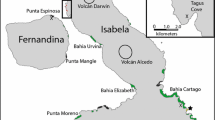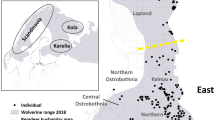Abstract
Well-characterized species introductions provide opportunities to compare the genetic signatures of known founder effects across classes of molecular markers. The release of small numbers of house finches (Carpodacus mexicanus) into the eastern United States in the 1940s led to substantial interest in the effects of this introduction on genetic diversity in this now abundant species, an issue that has been highlighted by a recent Mycoplasma disease epidemic that most intensively affects the introduced and potentially genetically depauperate house finch populations. Previous studies comparing genetic diversity levels in native and introduced house finch populations produced seemingly disparate results: comparisons based on amplified fragment length polymorphism, RFLP mtDNA, and allozyme markers found essentially equivalent levels of diversity in eastern and western populations, whereas microsatellite markers showed clear reductions in diversity in the introduced populations. Here we employ sequence variation at the ND2 mtDNA locus to further compare levels of diversity between the four native and five introduced house finch populations that were previously examined in the microsatellite study. We found substantially lower ND2 haplotype richness and diversity across all introduced populations of house finches. The majority of sequence variation (78%) was detected within subpopulations, with the remainder (22%) explained by the historical status of each population (native or introduced). Our results are consistent with previous microsatellite evidence for a founder effect during the introduction of eastern house finches, and suggest that the mtDNA founder effect was particularly severe, likely owing to a male-biased sex ratio at the time of introduction coupled with the lower effective population size of clonally inherited markers. We discuss how the inconsistencies between past studies of house finch diversity can inform the usefulness of distinct marker sets for detecting molecular signatures of founder events.


Similar content being viewed by others
References
Anne C (2006) Choosing the right molecular genetic markers for studying biodiversity: from molecular evolution to practical aspects. Genetica 127:101–120
Avise JC, Ball RM, Arnold J (1988) Current versus historical population sizes in vertebrate species with high gene flow: a comparison based on mitochondrial DNA lineages and inbreeding theory for neutral mutations. Mol Biol Evol 5:331–344
Benner WL (1991) Mitochondrial DNA variation in the house finch, Carpodacus mexicanus. MS Thesis, Cornell University
Birky CWJ (1991) Evolution and population genetics of organelle genes: mechanisms and models. In: Selander KK, Clark AG, Whittam TS (eds) Evolution at the molecular level. Sinauer Associates, Sunderland, MA, pp 112–134
Bock CE, Lepthien LW (1976) Growth in the eastern house finch population 1962–1971. Am Birds 30:791–792
Briskie JV, Mackintosh M (2004) Hatching failure increases with severity of population bottlenecks in birds. Proc Nat Acad Sci USA 101:558–561
Cant G, Geis HP (1961) The house finch: a new east coast migrant? East Bird Banding News 102–107
Clegg SM, Degnan SM, Kikkawa J et al (2002) Genetic consequences of sequential founder events by an island-colonizing bird. Proc Nat Acad Sci USA 99:8127–8132
Clement M, Posada D, Crandall K (2000) TCS: a computer program to estimate gene genealogies. Mol Ecol 9:1657–1660
DeYoung, Honeycutt R (2005) The molecular toolbox: genetic techniques in wildlife ecology and management. J Wild Manag 69:1362–1384
Dhondt AA, Tessaglia DL, Slothower RL (1998) Epidemic mycoplasmal conjunctivitis in house finches from eastern North America. J Wild Dis 34:265–280
Dhondt AA, Badyaev A, Dobson AP et al (2006) Mycoplasmal conjunctivitis spreads more slowly in native than in introduced range of the host. Ecohealth 3:95–102
Eberhard JR, Bermingham E (2004) Phylogeny and biogeography of the Amazona ochrocephala (Aves: Psittacidae) complex. Auk 121:318–332
Elliott JJ, Arbib RSJ (1953) Origin and status of the house finch in the eastern United States. Auk 70:31–37
Excoffier L, Smouse P, Quattro J (1992) Analysis of molecular variance inferred from metric distances among DNA haplotypes: application to human mitochondrial DNA restriction data. Genetics 131:479–491
Fallon SM (In Press) Genetic data and the listing of species under the U.S. Endangered Species Act. Conserv Biol
Grant PR, Grant BR, Petren K (2001) A population founded by a single pair of individuals: establishment, expansion, and evolution. Genetica 112/113:359–382
Harpending MM (1994) Signature of ancient populations growth in a low resolution mitochondrial DNA mismatch distribution. Hum Biol 66:591–600
Hawley DM, Hanley D, Lovette IJ, Dhondt AA (2006) Molecular evidence for a founder effect in invasive house finch (Carpodacus mexicanus) populations experiencing an emergent disease epidemic. Mol Ecol 15:263–275
Hawley DM, Sydenstricker KV, Kollias GV, Dhondt AA (2005) Genetic diversity predicts pathogen resistance and cell-mediated immunocompetence in house finches. Biol Lett 1:326–329
Hedrick PW (1999) Perspective: highly variable loci and their interpretation in evolution and conservation. Evolution 53:313–318
Hill GE (1993) House Finch (Carpodacus mexicanus). In: Poole A, Gill F (eds) The Birds of North America, no. 46. American Ornithologists’ Union, Philadelphia
Hill GE (2002) A red bird in a brown bag: the function and evolution of colorful plumage in the house finch. Oxford University Press, New York
Hochochka WM, Dhondt AA (2000) Density-dependent decline of host abundance resulting from a new infectious disease. Proc Nat Acad Sci USA 97:5303–5306
Honeycutt RL (2000) Genetic applications for large mammals. In: Demarais S, Krausman PR (eds) Ecology and management of large mammals in North America. Prentice-Hall, Upper Saddle River, NJ, pp 233–252
Keller LF, Jeffery KJ, Arcese P et al (2001) Immigration and the ephemerality of a natural population bottleneck: evidence from molecular markers. Proc R Soc Lond B 268:1387–1394
Kohlmann K, Gross R, Murakaeva A, Kersten P (2003) Genetic variability and structure of common carp (Cyprinus carpio) populations throughout the distribution range inferred from allozyme, microsatellite, and mitochondrial DNA markers. Aquat Living Res 16:421–431
Merilä J, Björklund M, Baker A (1996) The successful founder: genetics of introduced Carduelis chloris (greenfinch) populations in New Zealand. Heredity 77:410–422
Nei M, Maruyama T, Chakraborty R (1975) The bottleneck effect and genetic variability in populations. Evolution 29:1–10
Nei M (1987) Molecular evolutionary genetics. Columbia University Press, New York, NY
Posada D, Crandall KA (1998) Modeltest: testing the model of DNA substitution. Bioinformatics 14:817–818
Ramos-Onsins SE, Rozas J (2002) Statistical properties of new neutrality tests against population growth. Mol Biol Evol 19:2092–2100
Reed DH, Frankham R (2003) Correlation between fitness and genetic diversity. Conserv Biol 17:230–237
Rozas J, Sánchez-DelBarrio JC, Messeguer X, Rozas R (2003) DnaSP, DNA polymorphism analyses by the coalescent and other methods. Bioinformatics 19:2496–2497
Schneider S, Roessli D, Excoffier L (2000) Arlequin: a software for population genetics data analysis, Ver 2.001. Genetics and Biometry Lab, Department of Anthropology, University of Geneva, Geneva
Slatkin M, Hudson RR (1991) Pairwise comparisons of mitochondrial DNA sequences in stable and exponentially growing populations. Genetics 129:555–562
Sorenson MD, Quinn TW (1998) Numts: a challenge for avian systematics and population biology. Auk 115:214–221
Sorenson MD, Fleischer RC (1996) Multiple independent transpositions of mitochondrial DNA control region sequences to the nucleus. Proc Nat Acad Sci USA 93:15239–15243
Spencer CC, Neigel JE, Leberg PL (2000) Experimental evaluation of the usefulness of microsatellite DNA for detecting demographic bottlenecks. Mol Ecol 9:1517–1528
Sunnucks P (2000) Efficient genetic markers for population biology. Trends Ecol Evol 15:199–203
Vasquez-Phillips MA (1992) Population differentiation of the house finch in North America and the Hawaiian Islands. MS Thesis, University of Toronto, Toronto
Wang Z, Baker AJ, Hill GE, Edwards SV (2003) Reconciling actual and inferred population histories in the house finch (Carpodacus mexicanus) by AFLP analysis. Evolution 57:2852–2864
Zenger KR, Richardson BJ, Vachot-Griffin AM (2003) A rapid population expansion retains genetic diversity within European rabbits in Australia. Mol Ecol 12:789–794
Acknowledgments
We are grateful to A. Badyaev, J. Klicka, D. Swanson, J. Belthoff, T. Hendry, H. Williams, B. Hartup, A. Davis, and S. Altizer for providing genetic samples, and to L. Stenzler for help with laboratory work. We thank E. and M. Myers, B. Shepard, and C. Mann for allowing us to trap house finches on their properties. This research was supported by the Explorer’s Club Exploration Fund and by the National Science Foundation (Dissertation Improvement Grant DEB 0407543 and NIH-NSF “Ecology of Infectious Disease” DEB 0094456).
Author information
Authors and Affiliations
Corresponding author
Rights and permissions
About this article
Cite this article
Hawley, D.M., Briggs, J., Dhondt, A.A. et al. Reconciling molecular signatures across markers: mitochondrial DNA confirms founder effect in invasive North American house finches (Carpodacus mexicanus). Conserv Genet 9, 637–643 (2008). https://doi.org/10.1007/s10592-007-9381-4
Received:
Accepted:
Published:
Issue Date:
DOI: https://doi.org/10.1007/s10592-007-9381-4




